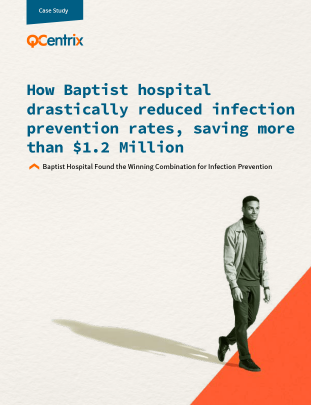

INFECTION PREVENTION
Embracing the evolution
We are entering a new era in infection prevention: prioritizing preventive protocols and technology-led innovation that will challenge healthcare organizations in the years ahead.

Sara Bienvenu, RN, MSN, CIC, Manager, Clinical Consulting & Infection Prevention
Unlock the value of clinical data™
Few areas of healthcare were as highly impacted by COVID-19 as infection prevention and its protocols. As the dust settles on 2020, the priority of infection prevention endures while healthcare leaders prepare for the next attack.
To thrive, leaders must direct more staff time to clinical data management or find innovative methods to meet their growing demands.
Our infection prevention expertise
Our suite of solutions offer flexible partnership options, ranging from all HAI surveillance and public reporting to a portion of those responsibilities.
Laboratory Identified (LabID) Infections:
- MRSA Bacteremia
- Clostridioidesdifficile
- CRE & other MDROs
Device Associated Infections:
- Central Line Associated Bloodstream Infections (CLABSI)
- Catheter Associated Urinary Tract Infections (CAUTI)
- Ventilator Associated Events (VAE)
- Pediatric Ventilator Associated Events (PVAE)
Procedure Associated Infections, including but not limited to:
- Colon surgeries (COLO)
- Abdominal hysterectomies (HYST)
- Knee arthroplasties (KPRO)
- Hip arthroplasties (HPRO)
- Coronary artery bypass (CBGB/CBGC)
- & more
Surgical Site Infections (SSI) Denominator Data
- Completion/reporting of denominator data for NHSN operative procedures selected for monitoring
NHSN Reporting and Management
- Completion of Monthly NHSN Reporting
- Monthly & Quarterly CMS IQR Report Validation
- Annual NHSN Survey Completion
- CDC NHSN Location Mapping Maintenance

Case study
Baptist Hospital drastically reduced infection rates, saving more than $1.2 Million
Baptist Hospital wanted to implement new patient safety programs to reduce the number of HAIs. However, their clinical teams were too consumed by the required abstraction workload to engage in improvement initiatives.
Partnering with Q-Centrix on infection screenings:
- Freed over 20 hours per month for the Baptist Hospital team
- Saved over $1.2 million in penalties and costs.
Keeping pace with change
About 40 years ago, the CDC conducted its Study on the Efficacy of Nosocomial Infection Control project. SENIC found that hospitals reduced their nosocomial infection rates by approximately 32% if their infection surveillance and control program included four components, including at least one full-time infection control practitioner per 250 beds. Two decades later, the Association for Professionals in Infection Control and Epidemiology and the Society for Healthcare Epidemiology of America updated and expanded recommendations for effective infection prevention and control programs that emphasized the importance of having sufficient resources.
Today, one full-time infection control practitioner per 69 beds is considered standard, but this resource expectation continues to evolve with market dynamics. As their responsibilities expand into new areas, infection preventionists must make certain their facilities are prepared to identify and respond to new viruses such as COVID-19, Ebola and Zika.
But while the IP profession continues to evolve, many hospitals have not kept pace with the need for appropriate staffing and resources.
How we work
A list of positive microbiology results or cases suspect for HAI are provided to Q-Centrix
Our IP experts perform HAI surveillance near real-time to identify infections using the NHSN protocol
As HAIs are identified, we notify you so your IP team can take preventative action
Optionally, our IP experts can report HAIs into NHSN and assume NHSN reporting and validation on your behalf



